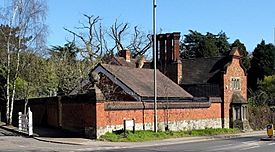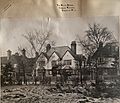Coombe, Kingston upon Thames facts for kids
Quick facts for kids Coombe |
|
|---|---|
 Coombe Warren Lodge, Coombe Lane |
|
| Population | 20,108 (2011 Census. Coombe Hill and Vale Wards) |
| OS grid reference | TQ208703 |
| London borough | |
| Ceremonial county | Greater London |
| Region | |
| Country | England |
| Sovereign state | United Kingdom |
| Post town | KINGSTON UPON THAMES NEW MALDEN |
| Postcode district | KT2, KT3 |
| Dialling code | 020 |
| Police | Metropolitan |
| Fire | London |
| Ambulance | London |
| EU Parliament | London |
| London Assembly |
|
Coombe is a historic neighbourhood in the Royal Borough of Kingston upon Thames in south west London, England. It sits on high ground, east of Norbiton. Most of the area was part of the former Municipal Borough of Malden and Coombe before local government re-organisation in 1965. It now shares borders with the boroughs of Merton and Sutton with, to the north, the small, inter-related neighbourhoods of Kingston Hill and Kingston Vale, beyond which is Richmond Park in Richmond; and Roehampton/Putney Vale in Wandsworth. To the east are public playing fields and Wimbledon Common.
Location
Coombe lies east of the Norbiton area of Kingston upon Thames. The neighbourhood was part of the former Municipal Borough of Malden and Coombe prior to local government re-organisation in 1965. It now shares borders with the boroughs of Merton, Sutton, Wandsworth and Richmond. To the north lies Richmond Park; to the east, Wimbledon Common.
History
Coombe centres on what was originally Coombe House, a large residence built in the 1750s. The house, now demolished, was located at the southwest corner of the intersection of present-day Coombe Lane (A238) and Traps Lane. Its red brick boundary walls can still be seen on the west side of Traps Lane.
The neighbourhood has a long history. Roman coins and other ancient remains have been found in the area around Warren Road. Coombe appears in Domesday Book as Cumbe. It was held partly by Hunfrid (Humfrey) the Chamberlain and partly by Ansgot the Interpreter. Its domesday assets were: 1½ hides; 4 ploughs, 12 acres (49,000 m2) of meadow, herbage worth 4 hogs. It rendered £8.
The Neville name has long been associated with the neighbourhood. In 1215 King John gave Coombe to Hugh de Nevill, and the area was known as Coombe Nevill by 1260. At the beginning of the 14th century the manor was held by William de Nevill. The 1911 Ordnance Survey map identified an estate known as Coombe Nevile at the intersection of George and Warren Roads and owned by Commander L. Chetwynd. The present-day cul-de-sac known as Coombe Neville is in the same location. Neville Avenue is a short distance away, south of Coombe Lane.
16th century records speak of a gallows in Coombe, most likely near what is now Kingsnympton Park estate; this was reputedly the scene of public executions.
In the early 1700s a public house known as the Fox and Coney was established at the intersection of George Road and Kingston Hill (A308). It was rebuilt in 1728 and soon thereafter was renamed the George and Dragon, operating as such until 1985, when it became the Kingston Lodge Hotel.
By 1761 Coombe was owned by John Spencer, 1st Earl Spencer, an ancestor of Diana, Princess of Wales and her son Prince William.
Coombe Warren was a wild woodland on the ridge known as Coombe Hill. It was used for hunting and public fairs. 'The Coombe Wood Highwayman', Jerry Abershaw, frequented the area in the late 1700s. Being based at the "Bald Face Stag" pub, he sheltered in the woods. An 1835 map placed Coombe Warren in an area now bisected by Warren Road between Kingston Hill (A308) and Coombe Lane (A238). Portions of the Warren are now covered by the Coombe Hill estate and Coombe Wood Golf Course.
In 1822 the Admiralty opened a semaphore station in the Warren, which was part of the semaphore line from London to Portsmouth. The station has disappeared, but survived in the name of "Telegraph Cottage."
At the time of the 1865 Ordnance Survey, the area west of Warren Road remained largely open country. By 1911 two golf courses were in place, as were a number of large estates located along George Road, including Coombe Croft (now Rokeby School for Boys), Coombe Ridge (now Holy Cross Preparatory School), Coombe Court, Coombe End, Ballard Coombe and Fairview.
- For further information on education in Coombe, Kingston upon Thames see the main Royal Borough of Kingston upon Thames article.
Numerous German bombs struck Coombe during World War II.
Today
Coombe is a prestigious residential location, and house prices in the area are commonly into the millions. It includes the Coombe Hill estate. Once the site of now-demolished Coombe Warren, a 19th century property built by architect George Devey, Coombe Hill estate today consists of Coombe Hill Road and cul-de-sacs such as Greenwood Park and Devey Close; and neighborhoods along Warren Road, George Road and Golf Club Drive.
Notable residents and visitors
- Actor Joss Ackland lived at Ravenswood Court.
- Edward Charles Baring commissioned George Devey to create several buildings, including Coombe Hill Stables (1863) and Coombe Warren Lodge.
- The scientist and spiritual leader John G. Bennett lived and taught at Coombe Springs until 1966 when he passed it to Idries Shah, who sold the estate for housing development.
- Kenelm Lee Guinness, member of the Guinness brewing family, racing driver, former holder of the world land speed record and inventor of KLG sparking plugs lived at The White House, Coombe Warren, Kingston Hill
- Malcolm Campbell, racing driver and former holder of the world land speed record lived at the junction of Kingston Hill and Warboys Approach.
- Donald Campbell, son of Malcolm Campbell and former holder of the world water speed record lived in the same house as his father on Kingston Hill.
- Tennis player Annabel Croft lives in Coombe Park.
- Dwight D. Eisenhower, when Supreme Allied Commander during World War II, based in Bushy Park, lived at "Telegraph Cottage" in Coombe, which was adjacent to the golf course which he used at weekends.
- Elizabeth I of England visited in 1602.
- John Galsworthy, author of The Forsyte Saga and winner of the 1932 Nobel Prize in Literature, was born in a house on Kingston Hill which was later named after him. Today, it is a care home for the elderly.
- William Ewart Gladstone, British Prime Minister and Chancellor of the Exchequer, spent extended periods as a house-guest of friends in Coombe.
- British politician George Glyn lived in Warren House.
- Earl Haig (1861-1928), World War I general, lived at Ravenswood Court.
- One of Saddam Hussein's daughters had a house in Golf Club Drive for a number of years..
- Sir Leonard "Len" Hutton, English cricketer, lived on Coombe Neville in the late 1960s.
- Coombe House was owned by Robert Jenkinson, Lord Liverpool (Prime Minister, 1812–27), and later by Prince Adolphus, Duke of Cambridge, a son of George III.
- Dame Nellie Melba lived in a house here for many years.
- Elisabeth Murdoch, media executive lived in Coombe for several years.
- Sir Wilfrid Sheldon, KCVO, a consulting paediatrician and physician paediatrician to the Household of Queen Elizabeth II, lived on Edgecombe Close after his retirement in 1967.
- Jimmy Tarbuck, English comedian and entertainer and his wife live in Coombe.
- Rolling Stones guitarist Ronnie Wood used to live in a Victorian-era home known as Holmwood on Kingston Hill, opposite the entrance of Coombe Park and near Galsworthy House.
Gallery
Education
Images for kids









